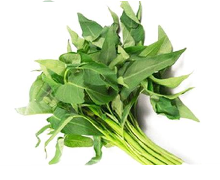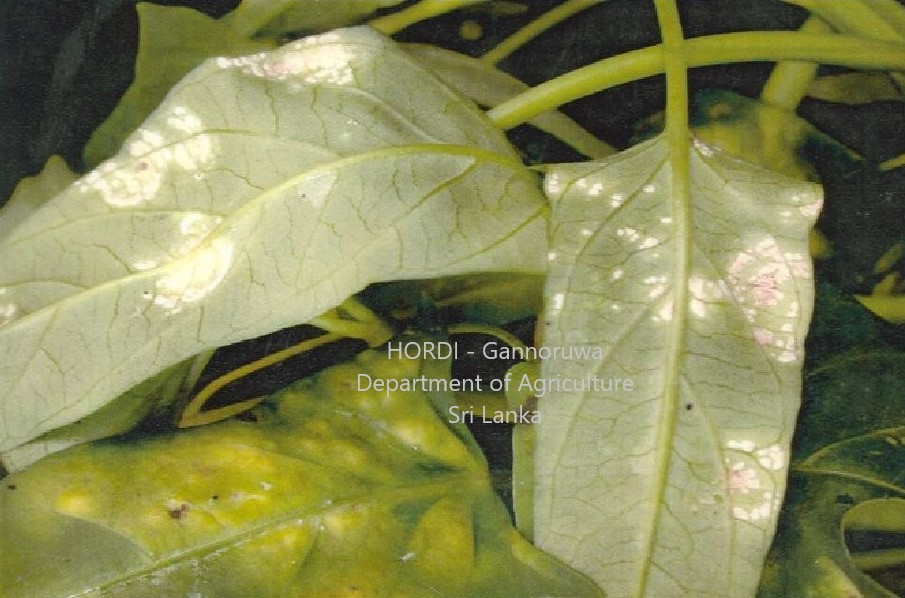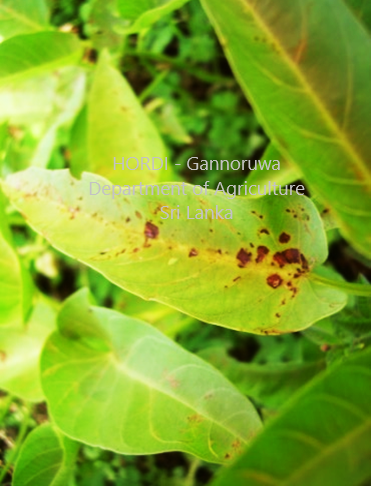
- Address : P.O. Box 11, Gannoruwa rd, Peradeniya, Sri Lanka
- E- Mail : director.hordi@doa.gov.lk
- Telephone :(+94) 081-2388011-12-13
- Fax :(+94) 081-2388234

Kang Kung
(Ipomea aquatica)
Kang kung is a popular leafy vegetable. It is widely and commercially grown on the water remaining lowlands in many parts of the island.
Available Types
There are two types depending on the color of the plant stems, leaves and flowers
1.Purple type
The stem and flowers are purple in colour. Commercially grown in some areas in the country. Latex is relatively high.
2.Green type
Stem is green in colour. The flowers are white. Two species have been identified as indigenous and Thai. Both of these varieties are commercially cultivated. The milky nature of these varieties is relatively low and has become popular.
According to the growth pattern, there are two types;
- Vine type – Stem purple-green. Grows as a runner.
The flowers are purple.
- Shrub type – Stem green. The flowers are white. Grows as a shrub.
Climatic requirements/ Areas suitable for cultivation
It can be grown in any area in the country when there is sufficient water except in upcountry areas. It is widely grown in the wet zone due to its higher water requirement.
Soil
The crop can be grown successfully in waterlogged marshy lands as well as in highland areas with frequent watering. Flowering occurs quickly if watering is neglected in highland cultivation. Kankun also thrives well in lakes, swamps and waterways in the dry zone. Slightly acidic soils pH between 6.00 – 7.00 is more suitable for cultivation.
Planting Materials
Stem cuttings and seeds can be used as planting materials Thai variety can be used for seed production and seed production takes place well at low temperatures during November, December and January.
20-30cm long stem cuttings are used for planting. Leaves should be removed from the stem before planting.
Planting materials should be taken from a healthy crop.(pest and disease free)
Time of cultivation
The crop can be grown at any time during the year in low lying areas where water is available. It is better to start cultivation during the rainy season as regular watering is required when cultivating in highlands
Field preparation and planting
Cultivation in low lying areas
Plough the land, collect water and allow weeds to decompose. Then arrange a few drains in the prepared land to drain off excess water when necessary. Crush the large soil particles and level the ground. Plant the cuttings at a spacing of 30×30 cm2. Cuttings can also be planted randomly. In water logged marshy lands, tip removed kankun cuttings can be broadcasted without preparing the land.
Cultivation in highlands
Plough the land and crush all the large soil particles and remove all the weeds from the field. Then prepare sunken beds in the prepared field and add excess water. Plant kankun cuttings with the spacing having 30x30cm2
Planting Materials
Stem cuttings and seeds can be used as planting materials Thai variety can be used for seed production and seed production takes place well at low temperatures during November, December and January.
20-30cm long stem cuttings are used for planting. Leaves should be removed from the stem before planting.
Planting materials should be taken from a healthy crop.(pest and disease free)
Fertilizer
Organic fertilizer
Well decomposed cattle manure, poultry manure or compost, 01 mt is added for1000 m2 of land.(1ton / 1000m2) before planting of kankun. Poultry manure is widely used by farmers as it reduces nematode attack and prevents weed spread.
Chemical fertilizers for 1000 m2
Fertilizer application | Urea Kg. | TSP Kg. | MOP Kg.
|
Basic fertilizer | 9.0 | 13.5 | 10.0 |
4 weeks after planting | 9.0
| – | – |
After each harvest | 4.5 | – | 1.5 |
Every 6 months | – | 6.5 | – |
Note 1: It is best to apply phosphorus and potassium as basic fertilizers after a soil test.
Water supply
Irrigation is practiced every 3-4 days. In dry weather, it is advisable to the crop more often without allowing them to wither.
Weed Control
Weeds growing with kankun should be removed from time to time and the field should be kept clean.
Pest Management
Leaf rolling and leaf eating catterpillars, worms aphids, thrips, mites and nematodes
If the attack is severe, cut, romove and destroy all the affected plant parts by burning
If it is necessary, apply recommended pesticides for tender new flushes
Disease Management
It is caused by fungus (Albugo sp.)
Disease spread :It is spread by soil and wind with infected plant parts.
Disease symptoms
- A white spot appears on the underside of the leaf. White powdery fungal spores are produced in spots on the underside of leaves. The collar region of the plant larger than normal. At the apical bud the leaf shrivels to the underside and stops growing. Infected leaves turn to yellow color and then fall off.
 |
Control of White Rust Diseases
- If the disease is spreading intensively, harvest quickly and remove diseased plant parts from the field and burn them.
- Providing proper nutrition for the cultivation.
- Avoiding unnecessary application of nitrogen fertilizers
- Following crop rotation
- Use healthy planting material when replanting.
Application of fungicides for commercial cultivation
- Apply N and K fertilizers as recommended after each harvest. Then apply a fungicide recommended below when sprouting
- Mancozeb 80 % WP- 32 g per 16 liter tank of water
- Chlorothalonil 75% WP- 20 g per 16 liter tank of water
- Chlorothalonil 500g/lSC – 30 ml per 16 liter tank
Apply the above fungicides again in 7 to 10 days.
Note: Continued use of the same fungicide can build resistance to by the fungus. Therefore, when applying fungicides, it is necessary to change the fungicide whenever possible. Application of fungicides should be stopped 2 weeks before harvest.
In home gardening and organic farming
Liquid inoculation can be used to control Trichoderma asperellum White Rust disease in home gardens and organic farming.
- Planting material treatment and planting: Trichoderma asperellum (liquid infusion (100 ml in 10 liters of water) immersed for 10 minutes and planted.
- Spray the Trichoderma asperellum solution every week after planting to thoroughly wet the plants and soil (pre-harvest period 7 days).
Note- Do not spray fungicides on lands where Trichoderma is used.
This is caused by the fungus Cercospora Sp.
Disease spread : It is spread by soil and wind with infected plant parts
Disease symptoms:
- Red or purplish brown spots appear and spread throughout the leaf. Later the leaf turns yellow color and dies
 |
Control of Brown Leaf Spot Diseases
- If the disease is spreading intensively, harvest quickly and remove diseased plant parts from the field and burn them.
- Providing proper nutrition for the cultivation.
- Avoiding unnecessary application of nitrogen fertilizers
- Following crop rotation
- Use healthy planting material when replanting.
Application of fungicides for commercial cultivation
- Apply N and K fertilizers as recommended after each harvest. Then apply a fungicide recommended below when sprouting.
- Mancozeb 80 % WP- 32 g per 16 liter tank of water
- Chlorothalonil 75% WP- 20 g per 16 liter tank of water
- Chlorothalonil 500g/lSC – 30 ml per 16 liter tank
Apply the above fungicides again in 7 to 10 days.
Note: Continued use of the same fungicide can build resistance to by the fungus. Therefore, when applying fungicides, it is necessary to change the fungicide whenever possible. Application of fungicides should be stopped 2 weeks before harvest.
In home gardening and organic farming
Liquid inoculation can be used to control Trichoderma asperellum brown leaf spot disease in home gardens and organic farming.
- Planting material treatment and planting: Trichoderma asperellum (liquid infusion (100 ml in 10 liters of water) immersed for 10 minutes and planted.
- Spray the Trichoderma asperellum solution every week after planting to thoroughly wet the plants and soil (pre-harvest period 7 days).
Note- Do not spray fungicides on lands where Trichoderma is used.
Harvesting
The first harvest can be obtained at about 30 days when the crop is grown in uplands and when it is grown in low lands, the harvest can be obtained around 20 days of planting. After that it can be harvested once in 20 -25days.
Yield
2000kg can be obtained from 1000 m2 area. ( 2000 kgs/1000m2 )
